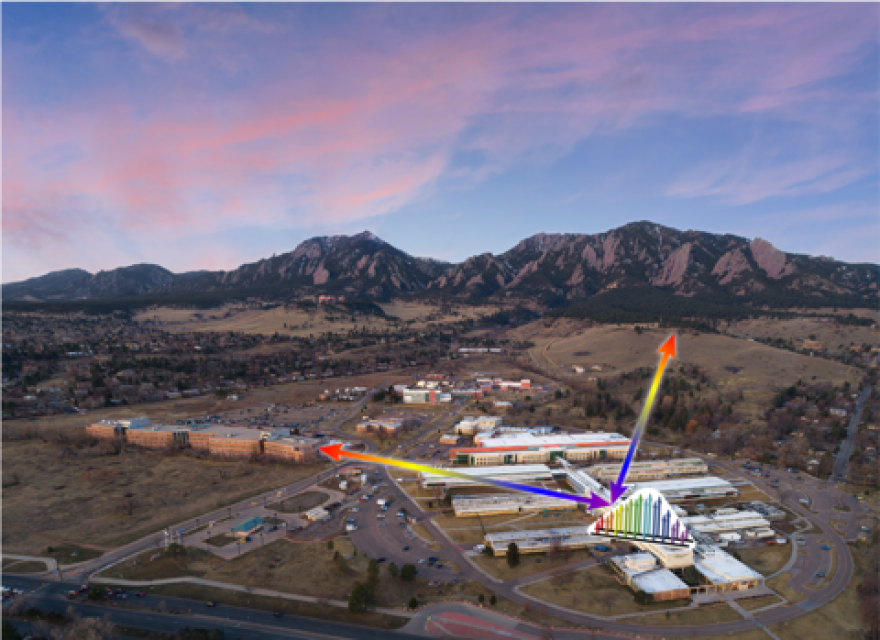The U.N. Intergovernmental Panel on Climate Change released a this week stating that immediate and extensive cuts in greenhouse gases are necessary to stabilize rising global temperatures.
While some emission sources, like vehicle exhaust, are difficult to mitigate, others are easier to address and could provide more immediate relief. In Colorado, multiple efforts are underway to find and fix methane leaks, which could make a big difference when it comes to fighting climate change.
Colorado State University biology professor Joe von Fischer is one of many scientists hunting for methane leaks in cities across the U.S.
“You have all these tubes that carry methane all the way from the point source to the homes and businesses where it’s consumed,” he said. “It’s literally like blowing air into a flute, it’s sort of coming out all the way along that.”
Von Fischer’s team started the project by strapping a laser system to their lab’s pick up truck and driving around Fort Collins. That led to a collaboration with Google Street View cars to map methane emissions.
The laser beam bounces between two mirrors. Some of that light is absorbed if it passes through methane molecules, which in turn can be measured to determine methane concentration. Not only did the scientists find sources of methane emissions, they also showed the leaking companies where to look.
“They just got out some wrenches, and they just tightened down these fittings and it was fixed,” said von Fischer. “It was that easy. And I was like, ‘Oh my god! This science has direct impacts on the world!’”
Methane accounts for about a quarter of global greenhouse gas emissions. But unlike fossil fuels, every pound of methane released into the atmosphere has . So, while natural gas is seen as a greener option, von Fischer said if too much (more than 5%) leaks into the atmosphere, we’re better off using coal.
But there is one piece of good news.
“If you release a kilogram of CO2 into the atmosphere, it’s going to be around for 100 years before it either dissolves in the ocean or it gets taken up by plant growth. It has a relatively long lifetime,” he said. “Methane is in the atmosphere, about half of it coming from human causes, and then it reacts and is destroyed on average over 10 years.”
That means cutting methane emissions would stop global warming quicker than reducing carbon dioxide. Other researchers agree with that assertion and the importance of identifying methane leaks.
“Atmospheric science is a complex problem that we need measurements of different gases over different scales,” said Kevin Cossel, a scientist at the National Institute of Standards and Technology. “Combinations of different measurement tools are important.”
Cossel and his team are also measuring methane concentrations with a laser. But this one, called a laser comb, works over larger distances: up to a half a mile. It shines light at a bunch of evenly spaced, distinct colors like the teeth on a comb. Their beam hits a mirror and bounces back. But again, some of it gets blocked by the various gases in the air.
“You know exactly what colors of light are being absorbed by each molecule, very very very precisely,” he said.

Different gas molecules block different teeth on the comb. The NIST system, which was recently updated, can now detect methane, carbon dioxide and other greenhouse gases over a large area, like an entire city.
“You measure over, usually, different numbers of mirrors. You can look at how much you measure from one path versus how much you measure from another path versus how much you measure from a third path,” said Cossel. “And you can use that to sort of pinpoint where the emissions might be coming from.”
These are just two examples of leak detection going on in the state. Andrew Bare, with the Colorado Department of Public Health and Environment, said they are also conducting aerial surveys over oil and gas operations to look for methane. And in the future, he said Colorado is looking into using satellites.
“All of this really reflects how important we think it is to detect methane leaks and generally reduce methane emissions in Colorado,” Bare said.
CSU’s Joe von Fischer said all of these efforts and technologies will need to work together to combat methane emissions.
“I think what’s interesting is that there’s value working at all of these scales,” he said. “Methane is a global problem, yet some of the sources cumulatively are causing methane enrichment on scales on the order of 20 yards.”
Colorado has set a goal to reduce statewide greenhouse gas emissions . These technologies, and more like them, will be critical for reaching that. Current state efforts are only projected to .





